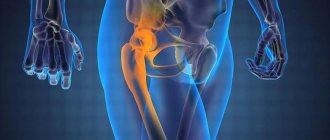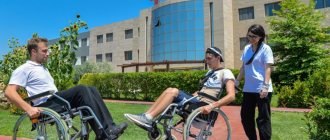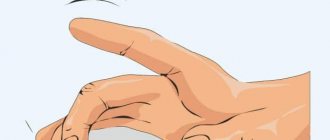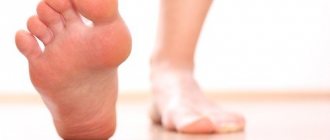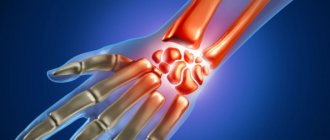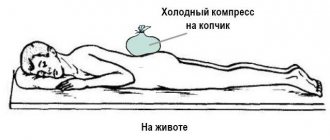Although a bruise of the hip joint in older people due to blows or falls is not accompanied by a serious wound on the skin, the injury is considered serious due to damage to soft tissues and organs: ruptures of ligaments, connective tissue, muscles and tendons, blood vessels and nerves. At the site of the bruise, blood collects and turns into a clot.
After complete penetration of blood into the soft tissues, a bruise will form, and the skin will gradually change its color: from blue-purple to greenish and yellow. The soft tissue over the protrusions of the bones is most damaged: the greater trochanter, the iliac crest and the branch of the pubic bone, the ischial tuberosity. The entire anterior outer surface of the thigh and the tissue around it may be affected.
Typical sites of bruises on the bony protrusions in the front of the pelvis and thigh
Bruises in older people should not be ignored, even in the absence of severe pain. It may appear later, so you need to go to the emergency room. In order for the doctor to make a diagnosis, it is important to describe in detail how the victim was injured and take an x-ray.
The image may indicate the presence or absence of a crack, fracture of the femoral neck or femoral head. If the damage to the muscle and ligaments cannot be seen on the x-ray, then resonance imaging is performed.
Typical sites of bruises of the bony protrusions of the pelvis: rear view
Causes
The most common root causes of pelvic soft tissue contusion are:
- Falling to the side due to loss of balance. Most often, for this reason, injury occurs in elderly people.
- A powerful blow when the side or upper part of the thigh collides with heavy objects.
- Injuries in an accident. Most often, damage occurs during road traffic accidents.
- Playing some sports. Football and hockey are extremely traumatic. A bruise occurs when a blow is struck to the thigh area.
According to statistics, very often people get a bruise to the hip while playing sports. The risk group includes older people, especially in winter when there is ice.
Symptoms
The severity of symptoms during injury depends on the severity of the injury. The main symptoms of a pelvic injury from a fall:
- The strength of the pain syndrome varies in intensity: from aching to quite sharp. At the very beginning, after injury, the pain is distributed throughout the entire limb. A day later, the pain syndrome is determined mainly around the injured area.
- Movement of the injured limb is almost impossible due to severe pain.
- In the area of injury there is a hematoma, cyanosis and slight swelling. The damage reaches its maximum permissible size and characteristic purple color after a couple of days.
- Upon palpation, a local increase in temperature is detected.
- The damaged area turns red, which is associated with dilation of the blood vessels of the epidermis.
- Changes in the functional activity of the limb. The person experiences discomfort. Lameness occurs due to the fact that swelling hinders movement.
It is important to understand that if a day has passed since a pelvic injury from a fall, and the symptoms are becoming more and more pronounced, then this should alert you. It is important to take immediate action to help the person, which will greatly facilitate the process of treating a hip injury and rehabilitation.
Treatment
Treatment of hip and hip injuries is based on an integrated approach and includes methods, the choice of which depends on the severity, nature of the injuries received, and the individual physiological characteristics of the patient. It is mandatory to use techniques such as physical therapy and gymnastic exercises, which must be performed to restore mobility and normalize the elasticity of the damaged joint.
For minor bruises, the treatment of which does not require medical intervention, it is recommended to use alternative medicine recipes that will help quickly relieve pain, eliminate discomfort, and improve overall well-being. However, before using such methods, you should definitely consult with your doctor to exclude possible contraindications.
Traditional methods
Treatment of a hip joint injury must begin immediately after injury, otherwise there is a high probability of developing various kinds of complications, which include the formation of blood clots in the joint cavity, as well as the accumulation of exudate. The main methods used for most types of injuries are the following:
- Regardless of the severity of the injury, the patient is prescribed medications that have anti-inflammatory properties that will help prevent the development of inflammatory processes or eliminate them, if they are already observed.
- To relieve tissue swelling, it is recommended to regularly apply ice or cold bandages to the affected area, which will also help eliminate pain. To stimulate regenerative processes, it is possible to prescribe massage sessions, which should only be carried out by a specialist.
- For various types of fractures, it is practiced to apply a fixing plaster bandage, which the patient must wear for several months, that is, until the bone tissue is completely restored. In severe forms of fractures, for example, complicated by displacement or the formation of several bone fragments, surgical intervention is mandatory.
- In addition, surgical manipulations are used when clots formed from hemolymph and decay products form in the joint tissues.
- To stimulate regenerative processes and reduce pain, the patient is prescribed to undergo physiotherapeutic procedures, which include laser therapy and magnetic therapy.
- At home, you can use the following methods to relieve pain: apply a bandage of finely grated raw potatoes, fresh cabbage leaves or burdock leaves to the affected area. The bandage should be secured with elastic bandages and kept in place for at least three hours.
It must be emphasized that during the first five days from the moment of injury, the patient must remain in bed.
Further, if there are no contraindications, it is possible to apply minor loads to the injured limb. For faster recovery, the patient is recommended to regularly do exercises under the supervision of the attending physician.
If you find an error, please select a piece of text and press Ctrl+Enter. We will definitely fix it, and you will get + to karma
First aid
Identifying a hip bruise at the top of the thigh is not that difficult. Signs of damage to this area are of a special nature. If symptoms of a hip joint bruise appear, it is necessary to correctly provide first aid to the person before treatment. Help includes:
- Completely immobilize the area of the injured limb. The leg must be raised so that it is slightly higher than the level of the body.
- Apply cold to the affected area. Due to the low temperature, the vessels begin to narrow, preventing the release of blood into the soft tissues and the formation of cyanosis and hematoma. Before applying cold, food from the refrigerator or ice must be wrapped in a cloth to prevent frostbite of the tissue.
- The compress will need to be changed from time to time. Leave it cold for no more than 20 minutes.
- In case of unbearable pain, the victim must be given an analgesic. Usually given Analgin, Ibuprofen.
If you have symptoms that indicate a bruise of the hip and hip joint, it is important to take the patient immediately to a medical facility.
Pelvic injury from a fall
A bruise is a blunt injury that is not accompanied by trauma to the skin. In case of injury, only muscle tissue and blood vessels are affected, and internal bleeding occurs. Blood begins to accumulate in the layers of connective tissue. Pelvic contusion from a fall is the most common injury during icy conditions.
Causes
Ice is very dangerous
A pelvic contusion occurs due to mechanical impact when falling from various heights. The cause may also be a strong blow from a heavy object. It could be stone, brick, ice. Injury can also occur as a result of a traffic accident, when a person falls on the road during a collision or hits the side of a car.
A bruise of the hip joint due to a fall can occur:
- When playing sports. While skating, performing gymnastics or acrobatic exercises, a person may fall by hitting various objects.
- When playing outdoor games.
- In case of a fall when there is ice on the road.
Soft tissue bruises are also diagnosed during the performance of official duties, for example, among construction workers.
Symptoms
Low back pain and soft tissue swelling
Symptoms vary in intensity and location. The first sign of a pelvic injury is aching pain.
It can occur either immediately after injury or after a few minutes. Depending on the severity and location of the injury, it is distributed over the entire limb or thigh.
After a day, it is localized mainly only in the area of impact of a solid object. Symptoms of a bruise also include:
- The appearance of a bruise. It forms in the place where the blow occurred. It reaches its maximum size in 1-2 days and becomes a burgundy-bluish color. Over time it turns blue and then turns green.
- Swelling of soft tissues. Appears along with a hematoma. Characterized by compaction of the damage site.
- Redness. Occurs as a result of dilation of blood vessels in the skin.
- Increased temperature of the skin in the area of injury.
- Impaired motor activity.
When you fall, the bruise does not appear immediately. It appears gradually and reaches its maximum size only after a certain time. When you press it slightly, pain occurs and a tightness is felt. In order to reduce the risk of large bruises, it is recommended to apply cold to the site of the injury for 5-10 minutes.
Diagnostics
X-ray examination of the hip joint
To determine the cause of the injury, the doctor first conducts an examination and studies the patient’s medical history. During an external examination, most signs of a bruise are revealed, and the volume and degree of damage are also determined. In addition, it is important for the specialist to determine the presence of motor activity disorders.
For an experienced doctor, an external examination of the patient is sufficient to establish a diagnosis and determine the method of therapy. But in order to exclude the development of complications and identify more severe injuries, the following diagnostic methods are prescribed:
- X-ray examination. The picture is taken in two projections. This allows us to exclude the presence of dislocations and fractures due to bruise of the hip bone.
- CT. Prescribed to prevent damage to bone tissue. It is also possible to obtain information about inflammatory processes provoked by internal bleeding.
- MRI. It is considered one of the most informative diagnostic methods. They will allow you to assess the condition of joint tissues and hematomas.
Timely diagnosis makes it possible to identify fractures, dislocations, subluxations and complications of injury received during a pelvic contusion due to a fall.
Treatment
Diclofenac ointment
Often, when a hip joint is bruised, treatment is carried out with the help of medications. In severe cases, surgery may be performed.
Conservative treatment
When injury to the pelvic bones and surrounding soft tissues is not accompanied by various complications, treatment is carried out according to the following scheme:
- Bed rest and creation of functional unloading. To do this, the leg is slightly raised. The patient must remain in this condition for three days. Crutches or a cane are then used.
- Cold application. An ice pack is applied to the injury site. This helps reduce the amount of bleeding.
- Prescription of anti-inflammatory drugs. Diclofenac or Ketoprofen are used." Voltaren is used for local exposure.
- Prescribing painkillers. Ketorolac or Tempalgin help relieve pain.
- Use of antiallergic drugs. They are used to relieve swelling. Suprastin is most often prescribed.
All medications are used until the symptoms of bruise and injury disappear, treatment then continues using physiotherapeutic methods. They help relieve swelling and inflammation, as well as prevent the development of complications. In case of injury to the hip joint, laser treatment, magnetic therapy, UHF, electrophoresis and myostimulation are prescribed.
After the pain has passed, it is recommended to perform physical therapy exercises. They are performed in a lying position. Exercise therapy helps speed up the healing process and restore motor activity.
Surgery
The operation is performed only in cases where complications arise and the inflammatory process spreads.
When the hematoma suppurates, it is dissected and drained. This allows you to remove purulent masses. The wound is treated with an antiseptic drug and sutured.
In cases where severe swelling is observed and blood reaches the muscles, dissection of the membranes of muscle tissue is prescribed.
The method of surgical intervention depends on the type of injury and the nature of the injury.
Complications
In the absence of treatment, in case of severe pelvic contusion due to a fall, various complications can occur. These include:
- Development of subcutaneous hematoma. In this case, puncture and removal of the contents are required.
- Infringement in the facial areas of the muscle tissue of the thighs and buttocks. This leads to sheath syndrome, which is accompanied by severe pain and numbness.
- Formation of ossifications. They are formed during intermuscular hematomas and are ossified muscle fibers. In some cases they require removal.
- Traumatic detachment of the epidermis of the hip joint. In medicine, detachment of the fat layer and skin is called Morel-Lavallee disease.
With repeated bruises, arthrosis develops over time, which is accompanied by pain and loss of motor activity.
Pelvic contusion from a fall is one of the most common injuries, especially when playing sports and in the event of icy streets. Treatment can be carried out at home, but if severe pain occurs and the hematoma spreads, you should consult a doctor. This will help avoid complications and loss of motor activity.
Source: https://nettravm.ru/ushib-taza-pri-padenii/
Diagnosis of injury
Before determining how to treat hip bruises, it is necessary to accurately determine the diagnosis. If you do not contact a specialist in a timely manner, the risk of progression of serious exacerbations significantly increases. Therefore, an important goal of diagnosis is to refute or confirm more complex concomitant injuries that affect the further course and duration of therapy.
The first step in diagnosis is examination by a professional. The result of the examination is to determine more accurate symptoms of the pathology and make a possible diagnosis. It is diagnosed already at the upcoming stage of examination using diagnostic equipment.
- Bruise of the elbow joint - symptoms, causes, treatment and consequences
To determine whether cracks or fractures are observed, as well as to establish the boundaries of the acute inflammatory process, the patient may be prescribed:
- X-ray examination;
- CT scan;
- Magnetic resonance imaging.
All of the above measures make it possible to make a diagnosis and determine how to treat bruises of the hip joint.
Diagnosis of hip bursitis
Our clinic uses effective diagnostic methods, complemented by innovative Western developments
Diagnostics takes place in stages and includes:
- Primary visual diagnosis. Collecting information from sources such as the patient’s behavior, gaze, appearance and breathing allows the doctor to identify the problem from the first minutes of communication.
- Survey. The conversation with the patient is based on a certain pattern of questions that help to clarify the problems with the patient’s body at the energy level. This is called the fine-tuning technique.
- Inspection. When examining a patient, the doctor uses a combination of Eastern and Western techniques to most fully assess his state of health, identify the root cause of the disease and hidden symptoms.
- Pulse diagnostics. The method allows you to make an accurate diagnosis, as well as determine the risk of complications and concomitant diseases.
- Load tests. Using this technique, the severity of the local problem is revealed.
In order to clarify the diagnosis made using Eastern techniques, traditional research methods (laboratory tests, instrumental and hardware diagnostics) are sometimes prescribed.
Treatment of injury
Treatment of a severe bruise of the hip joint is aimed at eliminating the main unpleasant symptoms of the injury and resuming motor activity of the limb. In this case, predominantly conservative methods are used.
Initially, the patient is shown complete rest; the affected leg is immobilized with a splint. Next steps include:
- bed rest for a couple of days;
- periodic application of cold to the site of injury;
- use of antiphlogistic, painkillers, antihistamines;
- physical education, which should be carried out already on the 3rd day;
- physiotherapy and massage.
Cases with exacerbations are treated in a hospital.
Conservative treatment
When considering how to treat a bruised hip joint, in practice the following drugs are often used:
- Antiphlogistic agents. Diclofenac, Ortofen, Voltaren in the form of ointments, injections, and tablets are effective.
- Analgesic drugs. The best are Ketorolac, Tempalgin.
- Antihistamines for swelling. Claritin, Diazolin, Suprastin.
These drugs help cope with severe pain and eliminate swelling on the first day after injury. Traditional medicine is also often included in the general treatment regimen. As soon as the pain decreases, you can and should begin physical exercise. They help develop the joint, eliminate puffiness and swelling, and strengthen muscle tissue.
Surgery
Surgical treatment of hip joint injury due to a fall is rarely resorted to. Only with secondary progression of infection in the damaged area is surgery performed. Usually two methods are used:
- Fluid under the skin on the knee after a bruise or injury: symptoms, first aid and treatment
- cutting and cleaning out the hematoma when pus appears;
- dissection of the muscle with severe hemorrhages and swelling.
If complications arise in the form of pinched buttock muscles, areas of ossification may appear. They need prompt removal. When soft tissue is detached from the bone outgrowths, a cavity appears that is filled with blood. This cavity also needs to be surgically cleaned and drained.
Use of traditional medicine
For such an injury, treatment at home is possible, but only if it is not severe. Typically, products are used in the form of rubs, compresses, and lotions.
The best recipes are:
- Honey and aloe juice . Pass the plant through a meat grinder and squeeze out the healing juice using gauze. Drop a little honey into it and mix well. Moisten a cotton pad in the resulting product and apply to the painful area. Compresses will help quickly eliminate swelling.
- Vinegar . To combat hematomas and swelling, use a compress of half a glass of warm apple cider vinegar, to which add a small spoon of salt and a couple of drops of iodine. Soak a gauze bandage in the solution and apply to the bruised area. Ice is placed on top of the bandage and everything is fixed with a bandage.
- Cabbage leaves . Take a couple of cabbage leaves, first knead and apply to the bruised area. This method allows you to cope with the acute inflammatory process and pain.
- Onion juice . Take an onion, peel and wash it. Then grate and squeeze out the juice using gauze. Dip a cotton swab in the resulting juice and apply to the painful area. The session should be carried out throughout the day, changing the lotion to a new one from time to time.
Folk remedies are quite effective, but to enhance the results they must be included in complex treatment.
Help for hip bruises
If a fall or blow to the pelvic bones is not accompanied by severe injuries requiring hospitalization of the victim in a hospital, he needs first aid to prevent complications:
- Transfer to a chair, bed, sofa.
- Apply a cold compress to the injury site, preferably ice wrapped in a rag. Applying ice to exposed skin can cause tissue frostbite. This will cause even greater complications to the injured area. As the ice or cloth soaked in water warms up, you need to replace the compress with a new one.
- If a hematoma appears at the site of the impact, you should apply an ointment that relieves swelling and helps the bruise resolve faster, for example, Troxevasin gel.
- Leave the person in a comfortable position. Avoid any stress on the leg to speed up recovery.
- To relieve pain, it is recommended to take analgesics and antispasmodics, which are allowed for the victim due to his state of health. If joints are injured, a traumatologist or surgeon may prescribe Nimesil or its analogues to relieve inflammation and swelling. At the same time, this remedy has analgesic properties. Take for no more than 7 days if a bruise of the hip joint is accompanied by unbearable pain.
- To fix the damaged vessel in order to reduce pain and prevent additional injury to the joint, you can use an elastic bandage and compression garments. In more severe cases, a splint may be applied or a special corset may be offered.
- As the pain subsides (after 2 days), the patient must begin gentle physical activity on the bruised leg in order to prevent ossification of the joint and restore elasticity to the soft muscles surrounding the joint. There is a special set of exercises for the hip joint that will help speed up recovery.
For more serious bruises in the pelvic area, surgical treatment may be recommended. This is relevant if a hematoma has formed inside and blood clots have entered the joint cavity. Such blood stagnation is drained and antibiotic treatment and suture treatment are prescribed. It is possible that the doctor will offer the option of physiotherapeutic treatment of internal hematoma using a shock wave, laser, or magnetic therapy. And only in the absence of positive dynamics, a surgical method of removing clots from the joint is used.
In general, bruises to the hip joint from a fall or blow from a blunt object disappear within 1–2 weeks and do not pose a threat to the patient’s health.
Therapeutic gymnastics for the hip area
When a victim goes to a clinic, the treatment procedure involves proper physical exercise. All exercises are performed under the supervision of a physiotherapist without jerking. If it is not possible to attend physical therapy procedures in the hospital every day, you can do physical activity at home. To do this, wear comfortable clothing that does not put pressure on the injured area. Exercises are performed on a flat surface or standing.
- To warm up the muscles, you need to take a horizontal position on the floor and perform circular movements with your legs, first with the sick one, then with the healthy one. Rotations are done alternately inward and outward with the legs bent at the knees. Movements are smooth, slow. At least 7 times in each direction.
- Without changing position, lift the straight leg up 7 times, alternately with the sick and healthy ones. No jerking.
- Side position (lie on your healthy side so as not to increase pressure on the injury). Slowly move the injured leg back and return to its original position. Perform 5-6 times.
- Change the horizontal position to vertical. From a straight body position, feet together, smoothly bend forward and lower yourself as far as the hip joint allows. Return to starting position. Perform at least 5 times. Gradually strive to reach the floor with your palms. This allows you to stretch the muscles and improve blood supply to the injured area.
- Take a stable chair and lean on the back with your hand on the side of your healthy leg. Slowly raise the injured leg to the side to the maximum possible height. Lower it smoothly. Repeat at least 8 times.
Rehabilitation period
After a severe injury to the hip joint, rehabilitation measures are prescribed, during which a number of exercises are performed. In each case, exercise therapy is individual, the following is usually indicated:
- Place yourself on your side so that the injured hip is on top. Gently move the limb back. Perform this exercise with extreme caution, without rushing. Repeat 5-6 times.
- Starting position: lying on your back. Start making non-sharp circular rotations with the sore limb - first inward, and then outward. Repeat these steps 8 times.
- Lean against the wall, resting your healthy side against the wall. Move the injured leg slightly to the side and carefully lift it. Keep your arm straight. Perform exercises 11-12 times.
Performing gymnastic exercises in the first stages of recovery should be strictly under the supervision of the attending physician. This will prevent additional damage. Also, in parallel during rehabilitation, physiotherapeutic procedures such as:
- laser therapy;
- magnetic therapy;
- electrophoresis;
- massage.
The purpose of such events is to accelerate restoration processes in the affected structures.
Possible complications
A severe bruise of the hip joint is dangerous due to a number of exacerbations, which more often occur if you do not timely contact a medical institution to receive a treatment regimen for a pelvic bruise due to a fall. Complications may be of the following nature:
- entry of pathogenic organisms and infection;
- arthrosis;
- tissue ossification;
- pinching of blood vessels, which can contribute to the accumulation of pus and the progression of gangrene.
Severe injuries can be complicated by synovitis, hemarthrosis, and damage to the periosteum. Later, the growth of connective tissue with the appearance of scar changes is possible. In some cases, myositis ossificans begins to progress.
- Treatment of grade 3 arthrosis of the hip joint: are there methods?
If you bruise the hip joint of the upper thigh, it is important to consult a specialist, since dysfunction of the joint can even cause lifelong disability.
Complications of bruise
If left untreated, myositis ossificans, trochanteritis, and rupture of the acetabulum lip may occur. Muscle fibrosis + myositis ossificans lead to the loss of full movement of the victim.
Myositis ossificans
With a bruise of the hip joint, myositis of the thigh often occurs. Hospitalization is not required, but outpatient treatment is prescribed. Myositis ossificans leads to partial ossification of the muscle, which manifests itself at an early stage of development with a slight limitation of joint and muscle movements.
Single injuries occur when a piece of periosteum comes off and gets inside the injured muscle. After this, bone tissue can form.
Myositis ossificans
Most often, the adductor and quadriceps femoris muscles undergo ossification. When the middle head of the quadriceps muscle ossifies, the extension contracture in the knee will increase.
Myositis ossificans is diagnosed by coral-like shadows in the muscles on an x-ray. If you press on these places, you can feel some compaction, and the patient will feel pain. Subsequently, these “coral clouds” turn into a single dense fabric.
Important. When diagnosing myositis ossificans, the following procedures are excluded: electric field, application of paraffin and massage, so as not to increase irritation in problem areas. You can use electrophoresis with sodium chloride, radon baths, x-ray therapy and dosed exercises. With increasing impairment of motor function, the mature focus of ossification is excised surgically.
Symptoms of myositis first appear as a soft swelling, similar to dough, then the tissue thickens. The operation is prescribed only after the lesion has been identified.
It can be up to 5 cm in diameter, and a jelly-like mass can surround the node. It is formed due to the degeneration of surrounding muscles.
Long-existing lesions with clear contours due to the proliferation of fibrous tissue are completely replaced by formed bone or contain inclusions of cartilage and bones. They are riddled with fibrous tissue and cysts. With early removal of formations, hematomas are formed inside the lesion.
Spread of ossification over areas of the trunk and joints
The ossification process can last for years, 10 years or more, spreading along the affected muscle and affecting areas other than the heart, diaphragm, eye muscles, tongue and larynx. In an elderly person, it is difficult to move the head, spine, shoulder blades, and all large joints. It is almost impossible to definitively cure progressive myositis ossificans, since there is no effective remedy for such a complication.
Death occurs due to ossification of the intercostal and abdominal wall muscles and respiratory failure. And also with ossification of the muscles of the lower jaw and loss of the ability to chew and swallow.
Trochanteritis
As a result of a bruise of the hip joint, the tendons become inflamed, which is called trochanteritis. Menopausal women especially suffer from inflammation, as they lose the strength and elasticity of their muscles and ligaments. In obese older adults, depleted tendons are subjected to even greater stress after injury.
Inflammation of the femoral tendons
Symptoms are manifested by throbbing or nagging pain in the “breeches” area - on the outer surface of the thighs. First, they occur when walking or during physical activity, and then at rest, intensifying in a lying position.
The main symptoms are later joined by accompanying symptoms:
- intense pain without limiting the range of motion of the joint;
- swelling appears on the injured thigh and abscesses of various types, which are attributed to a disease of tuberculosis origin;
- vegetative-vascular disorders on the affected leg;
- Pain syndromes appear with any minor overload of the legs, jolts, blows, past illnesses and excess weight.
Trochanteritis is often confused with arthrosis. Its difference is that upon palpation, pain points immediately react, but restrictions in the movement of the joint do not occur, unlike arthrosis.
Trochanteritis occurs:
- tuberculosis with damage to joints, tendons and bones;
- septic – due to the penetration of staphylococci (pyogenic bacteria) into soft tissues through skin lesions;
- aseptic – due to injuries or congenital skeletal defects.
To confirm the diagnosis, a general clinical blood test is performed from a finger and rheumatic tests - from a vein, and an x-ray of the hip joint.
Trochanteritis is successfully treated within a course of 10 days:
- non-steroidal drugs for inflammation: drugs: Indomethacin, Meloxicam, Ibuprofen, Diclofenac, Novalis, Nimid and ointments or gels: Voltaren, Diclak-gel, Dolobene, Indomethacin, Remisid;
- corticosteroid hormonal drugs, for example, Hydrocortisone - injection into the tendon area or Celeston;
- physiotherapy: laser therapy and ultrasound, electrophoresis, shock wave exposure, heating, paraffin baths, magnetotherapy, massage;
- anesthetic blockades with novocaine, lidocaine or anti-inflammatory drugs in the trochanteric area;
- folk remedies: dry heat, ointments based on medicinal herbs, pine resin in oil.
Surgical treatment is started in case of developed and severe trochanteritis: part of the affected bone is removed and physiotherapy and exercise therapy are prescribed.
Acetabular lip rupture
Due to a severe injury or fall, the acetabulum of the hip joint may rupture, that is, the cartilaginous rim that runs along the edge of the acetabulum due to its soft structure is affected. In this case, the continuity of muscle tissue, tendons, and femoral ligaments may be disrupted, which requires the necessary emergency assistance.
But, unfortunately, this injury is often not recognized for a long time, since severe pain has not yet occurred. Later, short-term pain becomes more intense, crunching and clicking appears in the joint.
Sometimes victims mistake the pain for a tendon strain and self-medicate. However, trauma is dangerous because of its long-term consequences.
When torn parts of the soft tissue of the lip come into contact with the cartilage of the joint, they become thinner, new healthy tissue is captured and damaged, and the symptoms intensify.
Symptoms of rupture appear:
- pain in the groin and buttocks;
- excessive accumulation of fluid at the site of injury;
- bruising and changes in skin color;
- decreased limb range or complete immobilization.
On the left – the lip is normal, in the center – a flap tear, on the right – a tear along the edge.
The diagnosis is confirmed by MRI and X-ray and using the Joseph McCarthy test. To do this, the patient must lie on his back and fix the pelvis by bending his legs.
The injured leg is then extended and the hip is externally rotated, then internally rotated. If the lip is torn, a painful click will occur; the patient will also feel pain when lifting the straightened leg, overcoming the doctor’s resistance.
Treatment
Conservative treatment is not effective in older people because tears cannot heal due to poor blood supply to the acetabular labrum. Non-steroidal drugs for inflammation and pain relieve symptoms, and exercise therapy relieves muscle spasms and corrects gait.
The geometry and severity of the gap itself are important here. With a small rupture, intra-articular disorders will not occur: arthrosis, chonomalacia. The joint can self-adapt when glucocorticoids are introduced into it: hydrocortisone, diprospan. But this is only a temporary measure.
If there is a large tear of the acetabular labrum, arthroscopy of the hip joint is performed. The torn lip is removed, eliminating the mechanical cause of the pain, or the torn part is sewn on, which dangles freely in the joint cavity. Occasionally, in case of extensive marginal avulsion of the acetabular labrum, an arthroscopic suture is applied.
Labral tear and arthroscopic suture
An elderly person with such an injury should avoid impacts and movements that lead to the impact of the neck of the femoral bone on the acetabular labrum.
Prevention
In order not to wonder how to treat a bruised hip joint, it is very important to follow preventive measures. This:
- comply with safety regulations at work;
- avoid physical overload;
- buy only high-quality and comfortable shoes;
- use personal protective equipment when working in production or choosing traumatic sports;
- look at your feet while moving;
- avoid slippery places and uncleared roads;
- if necessary, improve living conditions;
- comply with traffic rules.
Prevention of complications of injury consists of early implementation of a set of emergency medical measures, taking medications in accordance with the prescription of a specialist.
Diet for hip bursitis
During treatment and rehabilitation of hip bursitis, you must follow the following diet:
- do not eat sour and salty foods;
- introduce as many fiber-containing foods into your diet as possible;
- reduce consumption of protein and fatty foods;
- give up fried and smoked foods;
- do not drink alcohol or coffee.
General recommendations for effectively combating the disease are not enough. Doctors at our clinic develop an individual diet for each patient, taking into account his or her health status.
Risk factors
The causes of injury to this structure are:
- falling on one side due to loss of balance. Typically, a hip bruise due to a fall occurs in older people;
- a strong blow when the side or upper part of the thigh collides with a hard object;
- injury in an accident;
- practicing certain sports that are quite dangerous (hockey, football). A bruise occurs when a blow is struck to the pelvis or thighs.
Most often, this type of bruise occurs during sports. At risk are older people who often lose their balance and fall, especially in winter.
Symptoms
The distinctive symptoms of a hip bruise are:
- severe pain in the damaged area;
- lameness;
- increase in thigh size;
- formation of swelling and extensive bruising in the area of the bruise;
- impairment of motor abilities in the knee and pelvis area, which is caused by severe pain in the hip joint. Nevertheless, when walking, a person is able to walk, although with difficulties: the muscles attached to the bony apexes of the bruised joint work;
- increased pain when touching the bruised area.
If there are symptoms of a hip joint bruise, it is necessary to urgently take measures to help the victim. This will facilitate the further process of treatment and recovery.
Diagnosis of bruises in the hip area
Examination of a victim for a bruise of the hip joint is very specific, because during the initial examination, symptoms help to draw a conclusion about the location of the injury.
When palpating the bruise site, the presence of edema and internal hemorrhage is determined. To exclude fractures in the hip joint, which requires separate treatment, the traumatologist prescribes x-rays, which can reveal damage to the deep layers of tissue.
Additional examination procedures can be prescribed only if complications arise, if the recovery period is prolonged, but pain and stiffness in movement remain.
First aid
Recognizing a bruise of the hip joint is not difficult, since the signs of a pelvic injury are specific. If symptoms appear, it is necessary to provide assistance for the bruise.
You need to do the following:
- immobilize the area of the damaged joint. The limb should be above the level of the body;
- apply a cold compress or ice to the bruised area. Low temperature contributes to the narrowing of blood vessels, preventing blood from flowing out of them and the formation of a hematoma;
- change the compress several times (you can leave each one for no more than 20 minutes).
With such symptoms that indicate a bruise of the hip joint, it is necessary to immediately take the victim to a medical facility after providing first aid. This is due to the fact that the victim may experience distortion - sprain of the joint ligaments, or subluxation.
Diagnostic procedures
To carry out treatment procedures aimed at eliminating the consequences of the injury, an accurate diagnosis is necessary. Immediately after delivering the victim to a medical facility, the patient is prescribed to undergo diagnostic procedures, the most common of which is x-ray examination. If results of low quality or local damage are obtained, it is possible to use additional techniques, which include ultrasound and magnetic resonance imaging.
Diagnosis and treatment
To diagnose a hip bruise, the following measures are required:
- radiography;
- MRI to detect microfractures and muscle damage;
- scintigraphy to determine pathological processes extending to bone structures.
Once the diagnosis is clarified, the treatment process begins.
There are several methods for treating a bruise. Conservative therapy is as follows:
- ensuring the patient's peace;
- the use of strong painkillers that help suppress pain in the hip joint (Pentalgin);
- taking anti-inflammatory drugs (Nurofen);
- applying a splint to the damaged area.
For symptoms of severe bruising, surgical treatment is prescribed. In such cases, do the following:
- when soft tissue is detached, a puncture is performed to remove excess fluid from the muscle tissue, after which a bandage is applied;
- in case of large detachments, the fragments are removed through the incision, the empty cavity is drained, the access site is sutured and a bandage is applied;
- In order to reduce intramuscular pressure, the fascia is cut.
Also, for a bruise of the hip joint, treatment involves performing exercises to develop the damaged structure (circular movements of the thigh from a position lying on its side or standing, “Scissors” and “Bicycle” exercises).
Arthrosis of the hip joints (coxarthrosis) - symptoms and treatment
Treatment of arthrosis of the hip joints can be either conservative (medicinal or non-medicinal) or surgical. Conservative treatment is used at stages 1-2 of the disease, surgical treatment at stages 3. Surgical treatment may also be recommended at stage 2 in case of persistent pain and lack of response to conservative therapy [3][9].
Goals of conservative therapy:
- improve quality of life - reduce pain and increase joint mobility;
- stop or slow down the progression of the disease [7].
Non-drug treatments include:
- unloading the hip joint (reducing body weight, creating additional support and transferring part of the body weight to a cane or crutches);
- physical therapy;
- physiotherapeutic methods of treatment.
Treatment of coxarthrosis begins with non-drug methods, and physical therapy plays an important role. If the pain is severe, the patient should use a support. If the disease is severe and there are contraindications to endoprosthetics, the support must be used for life.
Drug therapy for coxarthrosis includes drugs that reduce the symptoms of the disease. These are analgesics, which include paracetamol, as well as drugs from the group of non-steroidal anti-inflammatory drugs (NSAIDs). NSAIDs are divided into non-selective (indomethacin, voltaren, ibuprofen) and selective (nimesulide, meloxicam).
Analgesics and NSAIDs for arthrosis of the hip joint are used short-term to relieve pain and inflammation. Currently, there is no proven advantage of one non-steroidal anti-inflammatory drug over another, so the choice of a specific drug depends on the side effects it causes and the specific clinical situation [7].
It must be remembered that NSAIDs have a number of side effects. When taken, the mucous membrane of the stomach and duodenum is affected, which may result in ulcers and bleeding. A number of NSAIDs have a toxic effect on the liver and kidneys. In addition, NSAIDs interfere with platelet aggregation, and, as a result, the patient has impaired thrombus formation and a tendency to bleeding. NSAIDs, when taken for a long time, suppress hematopoietic processes and can cause aplastic anemia and agranulocytosis. Taking selective NSAIDs causes significantly fewer complications.
Ointments and gels applied topically cause fewer side effects than oral medications. To treat arthrosis, drugs with a warming and pain-reducing effect are used. They may contain turpentine, menthol, nicotinic acid esters, salicylates, bee venom, capsicum. Applications of NSAIDs (indomethacin, diclofenac, voltaren) also have a good effect.
If there is no effect from paracetamol and NSAIDs or if it is impossible to find the optimal dose of the drug, centrally acting painkillers can be prescribed for a short time. These drugs include tramadol, which is prescribed in a dose of 50-200 mg/day. Dose selection is carried out by gradually increasing it by 25 mg.
If inflammation occurs, intra-articular injection of corticosteroids (diprospan, dexamethasone, kenalog) is used. Corticosteroids are used no more than 2-3 times a year, since more frequent use can lead to cartilage degeneration.
Slow-acting drugs that reduce the symptoms of the disease include chondroitin sulfate, glucosamine, avocado or soybean unsaponifiable compounds, and hyaluronic acid. These drugs are included in the recommendations of the European League Against Rheumatism for the treatment of arthrosis of the hip joints [7]. The drugs reduce pain and improve joint mobility.
Hip replacement is used in severe cases of stage III, when pain cannot be eliminated and joint mobility is significantly limited. Hip replacement leads to a reduction in pain, improvement in the functional state of the joint and the patient’s quality of life. The effect lasts for 10-15 years, after which repeated surgery may be required. During the operation, the hip joint is replaced with an artificial imitation made of ceramic, metal (titanium prostheses are most often used) or polymer [14].
What to do if you are injured
A bruise, if it is mild, can be treated at home.
For hip injury, the following folk remedies are useful:
- compresses from fresh cabbage leaves. It must be washed, lightly beaten and applied to the damaged area, secured with a bandage. In the first days after injury, this remedy helps eliminate swelling and relieve pain;
- compress with aloe. You need to take an aloe leaf, cut it in the middle, squeeze out the juice. Add a little honey to the resulting juice and mix. Lubricate the damaged area with the resulting mixture and secure with a bandage. Leave for several hours;
- mint based ointment. Take 50 g of mint and eucalyptus, chop, add 50 ml of fresh aloe juice. Rub the resulting composition into the injured joint up to 2 times a day.
Degree of injury
Before starting treatment, it is necessary to understand the condition of the limb. The more severe the injury, the more severe the treatment will be. It is important to exclude a fracture, because in this case only professional medical assistance will be needed.
In order to understand what to do with a hip injury, you need to determine the degree of damage:
| Degree | Damage Strength | Manifestations |
| 1st degree | The impact was weak | There may be no traces left at the contact point, or scratches may appear. The pain will be mild and fleeting. Such “mild” symptoms completely disappear by 3-4 days after injury. |
| 2nd degree | Moderate shock or impact | Damage to muscle tissue is already occurring here. Sensitive pain occurs at the point of contact, and swelling, hemorrhage, or even a large hematoma also appears. |
| 3rd degree | Is the impact strong? | Damage to the ligaments and tendons occurs, causing the loss of full motor ability of the limb. Also, the same symptoms are observed here as with the 2nd degree of injury. |
| 4th degree | Serious injury (such as a car accident) | This situation poses a certain health threat. There is an increase in general temperature and enlargement of the lymph nodes, which is associated with serious damage to the joint and all nearby tissues. Immediate medical attention is required. |
As can be seen from the above, bruise is different from bruise. Therefore, each situation requires its own individual approach. And it wouldn’t hurt to visit a doctor, even if at first glance the injury was not severe or does not cause visible damage.
Rehabilitation period
During rehabilitation, the patient is shown performing exercises from therapeutic physical culture complexes. A number of exercises are useful and must be performed as follows:
- Lie on your side so that your sore hip is on top. Gently move your leg back. You need to perform the exercise very slowly, repeat 5-6 times;
- lie down on your back. Begin to make gentle circular movements with the injured limb - first inward, then outward. Repeat the exercise up to 8 times;
- stand against the wall with the side of your body with a healthy lower limb. Move the affected leg slightly to the side and slowly lift it. The arm should be kept straight and to the side. Repeat up to 10 times.
The patient’s performance of exercises to develop the damaged joint should be supervised by a doctor at the initial stages to prevent additional damage.
Also, during the recovery period, the patient may be prescribed physiotherapeutic procedures: laser therapy, magnetic therapy, massage, electrophoresis. The purpose of such procedures is to accelerate regenerative processes in damaged structures.
